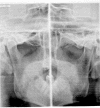A case report of the symptom-relieving action of an anterior flat plane bite plate for temporomandibular disorder
- PMID: 21243070
- PMCID: PMC3020490
- DOI: 10.2174/1874210601004010218
A case report of the symptom-relieving action of an anterior flat plane bite plate for temporomandibular disorder
Abstract
Splint therapy is a widely used modality for temporomandibular disorders (TMDs). However, questions remain regarding the mechanism of symptom relief. Recently, a relation between TMD and a discrepancy between the habitual occlusal position (HOP) and the anterior flat plane bite plate-induced occlusal position (BPOP) has been reported. Therefore, to understand the mechanism of the symptom relief associated with the use of a bite plate, the changes in both the HOP and BPOP values were observed during anterior bite plate treatment in a patient with TMD.
Case presentation: Anterior bite plate treatment was started in a patient complaining of arthralgia. A discrepancy between the HOP and BPOP values was recorded three days after the first visit; this discrepancy disappeared on day 6, and the disappearance was maintained between days 6 and 12. The disappearance was associated with a decrease in the severity of the patient's symptoms; however, the discrepancy reappeared after 15 days, coinciding with the complete disappearance of the patient's symptoms. Therefore, the effect of the bite plate on the resolution of the discrepancy between the HOP and BPOP values was interpreted as being unsustainable and occlusal equilibration for the BPOP was performed at 17 days. Thereafter, neither a discrepancy in the HOP and BPOP values nor any symptoms of TMD (right temporomandibular joint pain or limited jaw opening) reoccurred during a two-year follow-up period.
Conclusion: Within the limitations of the present study, the symptom-relieving action of an anterior flat plane bite plate on the resolution of occlusal discrepancy appeared to be temporary. This outcome supports previously reported conclusions that the effectiveness of stabilization splint therapy for reducing symptoms in patients with pain dysfunction syndrome does not differ significantly from that of other conservative therapies or of no treatment at all.
Keywords: Anterior flat plane bite plate; bite plate-induced occlusal position; occlusal discrepancy..
Figures





Similar articles
-
Occlusal adjustment using the bite plate-induced occlusal position as a reference position for temporomandibular disorders: a pilot study.Head Face Med. 2010 Mar 27;6:5. doi: 10.1186/1746-160X-6-5. Head Face Med. 2010. PMID: 20346167 Free PMC article.
-
Occlusal management for a patient with aural symptoms of unknown etiology: a case report.J Med Case Rep. 2007 Sep 12;1:85. doi: 10.1186/1752-1947-1-85. J Med Case Rep. 2007. PMID: 17848201 Free PMC article.
-
Relationship between habitual occlusal position and flat bite plane induced occlusal position in volunteers with and without temporomandibular joint sounds.Cranio. 2005 Jan;23(1):16-21. doi: 10.1179/crn.2005.004. Cranio. 2005. PMID: 15727317
-
Effectiveness of exercise therapy versus occlusal splint therapy for the treatment of painful temporomandibular disorders: a systematic review and meta-analysis.Ann Palliat Med. 2021 Jun;10(6):6122-6132. doi: 10.21037/apm-21-451. Epub 2021 May 10. Ann Palliat Med. 2021. PMID: 33977737
-
Reflections on the Michigan splint and other intraocclusal devices.J Mich Dent Assoc. 1998 Oct;80(8):32-5, 41-6. J Mich Dent Assoc. 1998. PMID: 9863432 Review.
Cited by
-
The effects of anterior bite plane on temporomandibular joint and mandibular morphology.Saudi Dent J. 2023 Sep;35(6):720-726. doi: 10.1016/j.sdentj.2023.06.002. Epub 2023 Jun 14. Saudi Dent J. 2023. PMID: 37823082 Free PMC article.
-
Temporomandibular Disorders Treatment with Correction of Decreased Occlusal Vertical Dimension.Open Access Maced J Med Sci. 2017 Oct 25;5(7):983-986. doi: 10.3889/oamjms.2017.201. eCollection 2017 Dec 15. Open Access Maced J Med Sci. 2017. PMID: 29362632 Free PMC article.
-
Occlusal splints-types and effectiveness in temporomandibular disorder management.Saudi Dent J. 2023 Jan;35(1):70-79. doi: 10.1016/j.sdentj.2022.12.013. Epub 2022 Dec 28. Saudi Dent J. 2023. PMID: 36817028 Free PMC article.
References
-
- McNeil C, editor. Craniomandibular disorders. guidelines for evaluation, diagnosis, and management. Chicago: Quintessence Publishing; 1990.
-
- Manns A, Miralles R, Guerrero F. The changes in electrical activity of the postural muscles of the mandible upon varying the vertical dimension. J Prosthet Dent. 1981;45:438–45. - PubMed
-
- Manns A, Rocabado M, Cadenasso P, Miralles R, Cumsille MA. The immediate effect of the variation of anteroposterior laterotrusive contact on the elevator EMG activity. J Craniomandib Pract. 1993;11:184–91. - PubMed
-
- Williamson EH, Lundquist DO. Anterior guidance: its effect on electromyographic activity of the temporal and masseter muscles. J Prosthet Dent. 1983;49:816–23. - PubMed
-
- Clark GT, Beemsterboer PL, Solberg WK, Rugh JD. Nocturnal electromyographic evaluation of myofascial pain dysfunction in patients undergoing occlusal splint therapy. J Am Dent Assoc. 1979;99:607–11. - PubMed
LinkOut - more resources
Full Text Sources
